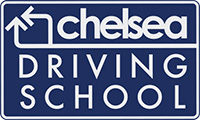THE PROCEDURE TO GAIN A UK DRIVING LICENCE
Check you’re allowed to drive.
- Apply for a UK provisional driving licence.
- Once the provisional licence has been received you can then start driving lessons.
- Book and take the theory test.
- Book and take your practical driving test.
- www.gov.uk/apply-first-provisional-driving-licence
- www.gov.uk/book-theory-test
- www.gov.uk/book-driving-test
Once you have received your provisional licence you can then contact Chelsea Driving School to start your driving lessons.
You can start driving lessons before you take the theory test.
THE THEORY TEST
Multiple-choice questions
You have 57 minutes to answer 50 multiple-choice questions.
Before the test starts you’ll get:
- instructions on how the test works
- the chance to do some practice questions to get used to the screens
How the test works
A question and several possible answers appear on a screen. You have to select the right answer.
Some questions are given as a case study. The case study will:
- show a short story that 5 questions will be based on
- be about a real life situation you could come across when driving
Leaving a question
You can ‘flag’ questions that you want to come back to later.
Changing your answers
You can go back to any question to review and change your answer at any point.
When you’ve finished
You can finish the multiple-choice questions part when you’ve answered all of the questions. You don’t have to use the full 57 minutes.
You can have a break of up to 3 minutes before the hazard perception test starts.
The Hazard perception test
Before you start the hazard perception test, you’ll be shown a video about how it works.
You’ll then watch 14 video clips. The clips:
- feature everyday road scenes
- contain at least one ‘developing hazard’ – but one of the clips features 2 developing hazards
You get points for spotting the developing hazards as soon as they start to happen.
What a ‘developing hazard’ is
A developing hazard is something that would cause you to take action, like changing speed or direction.
Example A car is parked at the side of the road and isn’t doing anything. It wouldn’t cause you to take action, so it’s not a developing hazard.
When you get closer, the car’s right-hand indicator starts to flash and it starts to move away. You’d need to slow down, so it’s now a developing hazard.
How the scoring works
You can score up to 5 points for each developing hazard.
To get a high score, click the mouse as soon as you see the hazard starting to develop.
You don’t lose points if you click and get it wrong. However, you won’t score anything if you click continuously or in a pattern.
You only get one attempt at each clip. You can’t review or change your responses.
| Test part | Pass mark | Points available |
|---|---|---|
| Multiple-choice questions | 43 | 50 |
| Hazard perception | 44 | 75 |
Once you have passed the theory test you can then book and take the practical car test.
THE NEW UK DRIVING TEST
(Manual and Automatic)
The UK driving test changed on Monday 4th December 2017. The changes are designed to make sure new drivers gain the skills required to help them drive safely for life.
The main reason for the change is so that you spend more time practicing on rural or high-speed roads instead of low speed side roads, so that it will better prepare you on these more dangerous roads for when you begin driving alone.
1) Satellite Navigation
The ‘independent’ driving part of the test will be increased from around 10 minutes to 20 minutes, which is about half of the duration of the test.
During this time most candidates will be asked to follow the directions from a sat nav. It won’t matter if you go the wrong way as long as you don’t make a driving fault whilst doing so.
1 in 5 driving tests won’t use a sat nav. You will need to follow traffic signs for 20 mins instead.
2) Manoeuvre changes
You will be asked to do only one of the following and it can be done during the independent drive
• Parallel park at the side of the road.
• Bay park – Either driving in to a bay and then reversing out (On test route) OR reversing into a bay and then driving out (At the test centre).
• Pull up on the right-hand side of the road, reverse for 2 cars lengths and then rejoin the traffic.
You might also be asked to do the Controlled Stop (Emergency Stop). This is in addition to one of the above manoeuvres and not instead of.
The ‘reverse around the corner’ and the ‘turn in the road’ will no longer be tested.
3) Answer the ‘show me’ question whilst driving
The examiner will ask a ‘show me’ question on the move. For example you might be asked to show how you would clean the windscreen using the cars controls and wipers. This can be done during the independent driving part of the test.
The ‘tell me’ question will be asked at the start of the test before you start driving. For example, ‘tell me’ how you would check to see if your brake lights were working.
4) The pass mark, duration of the test and cost will remain the same
Your allocated driving instructor will provide you with this information.
When you pass the practical car test your examiner will then inform you on how you will receive your full driving licence.

